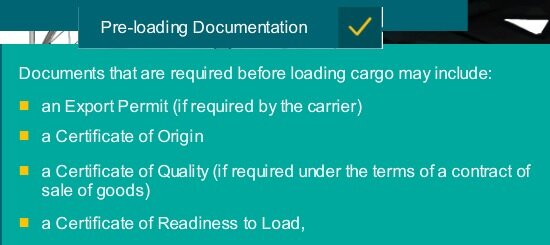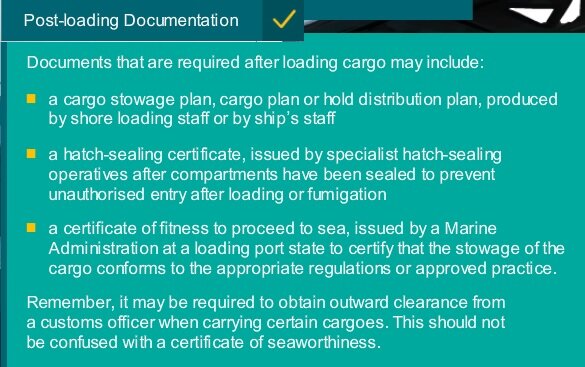
Fig: Bulk cargo pre loading documents
Goods are carried by sea under a contract of carriage between the shipper and the shipowner. The shipper may employ a forwarding agent to arrange the transport, while the Shipowner may employ a loading broker to control the allocation of space and advertise the service, and to make the loading arrangements and prepare documents on the shipowner's behalf .
When a shipper wants to send a particular cargo with a particular ship on a scheduled service, a "shipping note" for the consignment is completed by the shipper and forwarded to the shipowner or his agent. This note will have to contain a brief description of the commodity. The loading broker then compiles a list of the consignments intended for shipment, the booking list. This is sent to the ship to enable the Master to plan the stow and to the stevedore to arrange the loading. The shipper may receive a "booking note", which specifies that the carrier reserves space for a specified volume and kind of cargo in a named vessel between named ports. The broker may also issue a "calling forward notice" to the shipper, advising him of the time and place at which he is to deliver the goods.
When the cargo is delivered to the warehouse or to the ship, a receipt for that cargo must be obtained by the shipper. When the cargo is placed onboard, this is called a "mate's receipt". This receipt acknowledges that the goods ha ve been loaded and have been properly and carefully handled, loaded and stowed. If there are any damages to the goods before loading, this will be recorded on the receipt, and it is no longer "clean".
In some trades, it is customary for the shippers to have a "boat note" following the cargo. When the "boat note" is signed by the cargo officer aboard the ship, it becomes a "mate's receipt". With many shipping companies it is the practice to give an official "mate's receipt" irrespective of the fact that a boat note may be provided by the shipper. Modern practice is to present a copy of the shipping note as the boat note, which when endorsed, become the "mate's receipt".
Special tally companies are engaged by the shipowner to check or keep record of all cargo loaded into and discharged from a vessel. This is an essential part of cargo work in order to prevent claims upon the ship for so-called "short" discharge, i.e. when some of the cargo is missing. It is sometimes customary for the shipper or consignee to provide his own tally clerks, particularly with cargoes of a straight nature, such as bags, bales etc.
A copy of the "mate's receipt" will be returned to the shipowner, so that a "bill of lading" can be issued to the shipper. The "bill of lading" acknowledges that the goods have been "shipped in apparent good order and condition" if the "mate's receipt" is clean. Otherwise, comments are transferred to the "bill of lading". This document is issued under all forms of shipping, scheduled or not. The complete list of cargo loaded, as compiled from the "bills of lading" form the "manifest" of the ship. Customs regulations at most ports require at least one copy of the manifest and copies are also required for stevedores at discharging ports.
While cargoes are in transit, they may be sold so that the goods change ownership. Such a sale will be represented by the "bill of lading" changing hands. At the port of discharge, the consignment will be handed over to the party presenting the original "bill of lading".


![]()
Operation of sea going bulk carriers involved numerous hazards . Careful planning and exercising due caution for all critical shipboard matters are important . This site is a quick reference to international shipping community with guidance and information on the loading and discharging of modern bulk carriers so as to remain within the limitations as specified by the classification society.
It is vital to reduce the likelihood of over-stressing the ship's structure and also complying with all essential safety measures for a safe passage at sea. Our detail pages contain various bulk carrier related topics that might be useful for people working on board and those who working ashore in the terminal. For any remarks please Contact us
Copyright © 2010 bulkcarrierguide.com All rights reserved.
Although every effort have been taken to improve the accuracy of content provided the publisher of this website cannot gaurantee for errors. Disclaimer Privacy policy Home page
![]()